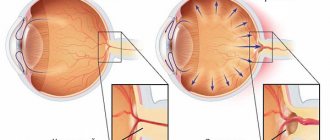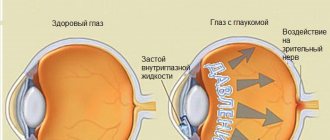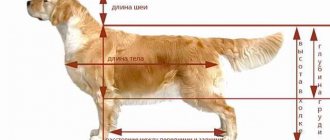Blood pressure in dogs, as in people, in the time interval between two heartbeats fluctuates from the lowest value, which is called diastolic, to the highest value, called systolic. Diastolic is recorded when the heart relaxes, and systolic is recorded when the heart contracts and pushes out blood.
During treatment or during a preventive examination, a dog’s blood pressure is measured with a special device called a tonometer and determined in quantitative terms. The unit of measurement is millimeters of mercury, i.e. mmHg. Art. It is written as a fraction, for example, like this: 120/80 (mm Hg). The numerator of the fraction is the systolic blood pressure, and the denominator is the diastolic blood pressure.
Do dogs suffer from high or low blood pressure?
Dogs, like people, are susceptible to changes in blood pressure depending on the influence of any external or internal factors. Their blood pressure may be normal, high or low. Obviously, increased or decreased blood pressure is an indicator that some kind of “failure” has occurred in the animal’s body, i.e., in its cardiovascular system. To stabilize blood pressure, it is necessary to find out what exactly caused the imbalance.
The lack of a dog owner's response to an increase or decrease in blood pressure in a pet can cause the development of a serious illness in the animal and even lead to the death of the dog.
Hypotension (low blood pressure)
In young, well-trained service, sporting or hunting dogs, physiological hypotension is observed, i.e. low blood pressure is considered normal. At the same time, it is important not to forget that the animal should look healthy: active, cheerful, with a good appetite, with regular bowel movements and urination.
Pathological hypotension occurs only under the influence of any primary disorders; as a rule, it is not long-lasting. It does not occur as a separate disease, i.e. There are no sick dogs with persistent hypertension.
Causes
- state of shock (during shock, pressure always drops due to vascular collapse - a sharp relaxation of all vessels);
- effect of anesthesia during operations;
- active bleeding - open (external) or internal (especially important to diagnose during surgical interventions);
- heart failure.
What to pay attention to
- weakness, apathy;
- lack of reaction to the owner, does not respond to the nickname, as if he is constantly sleeping;
- weak shallow breathing;
- the pulse is palpable weakly (due to weak blood supply to large veins and arteries);
- cold extremities;
- signals are triggered by life support monitors, to which the animal is connected during operations in some clinics.
How to help
Only a specialist can help in a situation where a dog’s blood pressure has dropped sharply and only in a veterinary facility. It is important to determine the cause, because Only when it is eliminated will therapy to normalize blood pressure be advisable. Usually this:
- anti-shock procedures;
- blood transfusion or blood-substituting droppers with special solutions (to restore the volume of circulating blood in the vessels);
- administration of drugs that stimulate cardiac activity.
High
A dog’s blood pressure may increase from time to time, for example, after an active street run or after a large, hearty meal. Such situations, as a rule, do not negatively affect the pet’s condition if it is healthy and young. It’s another matter when a dog has high blood pressure for a long time. This already signals an existing health problem.
A regular increase in blood pressure is called hypertension and is either a symptom of another disease or an independent disease. A single increase in blood pressure is called hypertension. What can cause increased blood pressure:
- stress (both negative and positive);
- diseases of the cardiovascular system;
- cerebral stroke or pre-stroke condition;
- kidney diseases leading to kidney failure;
- colds and all types of infections;
- malignant neoplasms;
- diabetes;
- Cushing's syndrome (increased production of cortisol or adrenocorticotropic hormone by the body);
- thyroid diseases;
- polycythemia (increased production of red blood cells in the blood);
- injuries to muscle tissue, bones and internal organs;
- aging of the body, during which blood vessels wear out and the elasticity of their walls is lost;
- taking medications that increase blood pressure.
It is often impossible to independently determine the root cause of increased blood pressure in a pet. Therefore, if for 2–3 days the blood pressure remains high at different times of measurement at rest, then this is a serious reason to contact a veterinary clinic.
Symptoms
It is not always possible to visually determine high blood pressure in a dog. This condition can be suspected based on the following signs:
- small blood vessels in the eyes burst;
- the animal's vision has become worse;
- the dog began to behave strangely, orientate itself worse in space, and stagger when getting to its feet;
- convulsive movements of the head or limbs appeared;
- urination has become much less frequent;
- pulse increased;
- excessive excitement or, on the contrary, lethargy appeared;
- wheezing began to be heard in the dog’s breathing;
- paws are swollen;
- the animal walks in a circle (like a horse in a circus arena), while its head is lowered down.
Each of these phenomena is a reason to contact a veterinarian, even if the animal’s blood pressure turns out to be normal.
Treatment
Treatment of problems associated with deviations in blood pressure in a dog from normal is the responsibility of a veterinarian. But in a situation where it is necessary to reduce blood pressure quickly, experts recommend the drug amlodipine or enalapril. For emergency lowering of blood pressure, injections of the drug “Naniprus” are suitable. The dosage depends on the age and weight of the animal; it is prescribed in the annotation for the medications.
Important: Just like humans, dogs have allergic reactions. This must be remembered when you use any medicine for the first time.
Treatment of hypertension in dogs is a complex process. What is included in therapy:
- use of pharmaceuticals. Medicines prescribed by a veterinarian must be used strictly as directed;
- a diet that excludes rare large meals. If you have high blood pressure, you should not give your dog fatty foods;
- normalization of physical activity. You should not take the animal for long walks or allow it to move excessively. The promenade should be calm, without speeding up, playing or fighting with other dogs.
Treatment methods for high blood pressure
If your pet has been diagnosed with high blood pressure, then under no circumstances should you self-medicate. Drug therapy is prescribed only by a doctor and consists of several stages:
Lower blood pressure to minimize the risk of developing or progressing internal organ disease. Typically, the doctor prescribes amlodipine and benazepril. It all depends on the individual dog and its sensitivity to medications. It is necessary to identify the initial cause of high blood pressure and begin its treatment immediately. The choice of therapy in this case depends on the cause.
A dog can only rely on the vigilance of its owner. Therefore, be attentive to your pet. Seeing a doctor in a timely manner will help avoid the development of many incurable diseases in your dog, thereby prolonging its happy life.
Currently reading:
- Thyroid dysfunction in dogs (hypothyroidism)
- Symptoms and treatment of primary and secondary glaucoma in dogs
- Detection of endocardiosis and its treatment in dogs
- How to recognize signs of dog poisoning from rat poisons
Low
Sometimes low blood pressure in dogs is a variant of the norm. This condition is possible in well-trained animals that have constant physical activity. Therefore, if blood pressure is low in hounds, hunting or working dogs, then this is a normal physiological phenomenon. In other cases, a decrease in pressure indicates some pathology.
A condition in which there is a pathological decrease in blood pressure is called hypotension. Hypotension is always a symptom of some disease or condition, such as shock, heart failure, internal bleeding, or blood loss due to injury.
It is difficult for a person far from veterinary medicine or medicine to diagnose internal bleeding or heart failure. With such problems, the only obvious symptom is a sharp drop in blood pressure. That's why it's so important to monitor your pet's blood pressure.
Symptoms
Some symptoms of low blood pressure in dogs are similar to those of high blood pressure, but some are completely different:
- apathy, lethargy;
- drowsiness, up to loss of consciousness;
- weak breathing;
- poorly palpable pulse;
- cold paw pads.
Treatment
Only a veterinary clinic doctor can diagnose the problem that caused the drop in blood pressure (especially a sharp drop). In this case, you cannot waste time; you should immediately take the dog to the clinic. The veterinarian will check your dog's low blood pressure and determine the underlying cause of the hypotension.
What the specialist will do:
- will carry out procedures to bring the animal out of shock;
- will give a blood transfusion if the decrease in blood pressure is caused by blood loss;
- will give injections (or make IVs) of drugs that stimulate the heart.
The concept of blood pressure, physiological norms in dogs, methods of determination
Arterial (or blood) pressure is the indicator with which blood literally presses on the vascular walls at the moment of heart contraction (systole) and the moment of its relaxed state (diastole). It is designated by two numbers separated by a fraction - X/X and measured in millimeters of mercury (mmHg). The first indicator is systolic, the second is diastolic. There is a dependence of blood pressure values on the condition of the vessel walls and heart rate.
Normal blood pressure in dogs is very variable and ranges from 110-145/60-95.
Fluctuations strongly depend on breed and size. Typically, the larger the individual, the higher the performance. But there are exceptions - in some miniature breeds the indicators can be in the range of 130-135/75-85.
How to measure a dog's blood pressure at home?
Measuring blood pressure is called tonometry. You can perform this manipulation either yourself, or by calling a veterinarian at home, or in a specialized medical facility. institution, for example, in the veterinary clinic “Svoy Doctor”. In veterinary practice, there are 2 ways to measure a dog’s blood pressure:
- invasive, i.e. inside the body. It is carried out during surgical operations by inserting a catheter of a measuring device into the dog’s artery;
- surface. Performed with a veterinary tonometer. The mechanism of its action is similar to the operation of a tonometer for measuring blood pressure in humans.
Obviously, tonometry can only be performed at home using the second method. You can purchase the device at any veterinary pharmacy; it is sold without a prescription.
There are 2 types of tonometers:
- mechanical, air is pumped into the cuff by pressing a special bulb pump with your hand, pulsation is measured with a stethoscope. They listen to the pulsation and correlate it with the readings of the device, showing what pressure the dog has;
- semi-automatic tonometer. The cuff is inflated manually with a bulb, and the readings are displayed on the instrument panel;
- automatic, in this device all actions to take blood pressure readings occur automatically after pressing one button.
To independently measure blood pressure, experts recommend using semi-automatic or automatic tonometers. They are easy to use and have an affordable price.
Algorithm of actions:
- put the dog down or sit down;
- Place the cuff of the device on the back paw or the base of the animal's tail. Make sure that the cuff does not tighten the limb, but also does not hang loosely on it;
- press the power button. The automatic blood pressure monitor will immediately begin measuring blood pressure. When working with a semi-automatic device, you need to inflate the cuff manually using a bulb;
- wait until the measurement is completed. In this case, the numbers on the panel will stop changing and the final measurement result will be displayed on the screen;
- repeat blood pressure measurements 2 – 4 more times. This is necessary to obtain a more objective result. The average of the obtained indicators should be taken as the final measurement value.
Tip for measuring your dog's blood pressure if you don't have a veterinary blood pressure monitor: use a medical blood pressure monitor with a pediatric cuff. Please note that the readings may differ slightly from the actual ones.
How to determine pressure?
To measure, as in humans, a tonometer is used.
Tonometry is a non-invasive technique. A cuff is placed on the animal's tail, hind leg, or forearm, and the veterinarian measures the blood pressure. The procedure is not painful and is carried out very quickly, the doctor immediately receives pressure data.
Of course, single data is not enough to make a diagnosis, so it is necessary to monitor your pet’s blood pressure regularly. The clinic usually takes three to five measurements for a more accurate result.
Prevention
A healthy and cheerful dog is a joy for the owner. Therefore, it is extremely important to pay attention to all factors that may be the probable cause of your pet’s ill health, including an increase or decrease in blood pressure.
Preventive measures to keep your dog's blood pressure in the normal range:
- dietary, but nutritious and regular meals;
- daily walks in the fresh air with physical activity appropriate for the dog’s age;
- absence of stressful situations;
- following the veterinarian's recommendations if the dog has already been diagnosed with hypertension. As a rule, this is a lifelong use of medications that lower blood pressure;
- periodic blood pressure measurements and, if necessary, contact a veterinary clinic.
Only if you follow these recommendations can you be sure that your dog’s blood pressure is normal. This will increase your dog's chances of a healthy and happy life.
Causes of high blood pressure in pets
The main reason for changes in blood pressure in an animal, as a rule, lies in the age of the animal: after all, only young and absolutely healthy dogs can have internal organs and systems work without failures. But this is not the only possible factor; blood pressure problems also lead to:
- Stress caused not only by negative, but also by positive reasons.
- Disorders of the heart, blood vessels, kidneys.
- Serious diseases (such as diabetes or any neoplasms).
- Presence of injuries.
Timely detection of deviations in blood pressure in dogs will help to recognize health problems and allow them to be dealt with quickly in order to, with the help of medicine, avoid serious and sometimes fatal complications and, accordingly, health consequences.
Symptoms and treatment of blood pressure abnormalities
When talking about high or low blood pressure, the basis is usually taken not from its systolic or diastolic level separately, but from a value called in medicine and veterinary medicine mean arterial pressure (MAP). To calculate the value of this indicator, a complex formula is used, which is the difference between the upper and lower blood pressure divided by 3, to which the diastolic indicator is added again.
For example, if, after measuring the intensity of the effect of blood on the walls of a dog’s blood vessels, the tonometer showed a result of 110/60, the SBP value will be: (110-60)/3+110=126 (mm Hg).
Mandatory monitoring of mean arterial pressure in a dog is necessary, in particular, in the following cases:
- for severe chronic diseases, for example, along the kidney line;
- during an acute inflammatory process, including as a result of injury or sepsis;
- when using anesthesia, as well as potent drugs (for example, various neurotransmitters, vasodilators, etc.).
In such situations, the readings of a tonometer or other similar device will allow the necessary measures to be taken in a timely manner to compensate for the patient’s deteriorating condition and prevent irreversible consequences. At the same time, preventive measurement of blood pressure during a routine appointment with a veterinarian is also a very important procedure, since it allows you to establish normal values for a given particular animal or, possibly, identify a particular pathology at the initial stage of its development, when the clinical symptoms of the disease are not yet noticeable .
Increased
It is customary to speak of high blood pressure in a dog if:
- the SBP value exceeds 130–133 mmHg;
- The most accurate oscillometry result displays readings greater than 200/110 mmHg.
A similar condition in both medicine and veterinary medicine is called hypertension (and not hypertension, as many mistakenly believe).
Important! Hypertension is the name of a disease characterized by persistent, chronic high levels of blood pressure, while the same symptom, which is detected at a given specific moment and can be associated with a variety of reasons, including short-term ones, should be called hypertension.
External signs of hypertension in a dog are:
- hemorrhages in the eyes;
- “running” look;
- disorientation in space;
- uneven, unsteady gait;
- labored breathing;
- rapid pulse;
- anxiety;
- vomit;
- swelling of the paws.
Hypertension does not necessarily indicate that the animal is unhealthy. For example, the heart releasing an increased portion of blood or a sharp narrowing of blood vessels often causes stress, pain, severe physical activity or exposure to another unfavorable factor. Small breeds of dogs are especially susceptible to this risk; it is not for nothing that veterinarians even have a special term for this - lapdog hypertension.
So-called secondary hypertension, which requires study, diagnosis and treatment, is a condition in which high blood pressure is a symptom of a systemic internal disease, for example:
- kidney problems (nephritis, nephrosis, microhematuria, proteinuria, renal failure);
- heart pathologies (hypertrophy of the heart muscle, heart failure);
- liver dysfunction;
- increased levels of cortisol in the blood (Cushing's disease);
- hormonal imbalance associated with increased secretion of the thyroid gland (hyperthyroidism);
- diabetes mellitus;
- obesity;
- neoplasms (primarily along the adrenal glands - pheochromocytomas, etc.).
Did you know? The percentage of blood volume to body weight varies from animal to animal. In humans, for example, this value is 7%, in a horse - 9.8%, in a cat - 5.7%, and in a dog - 6.4%.
To prescribe the correct therapy, of course, it is necessary to establish the cause of hypertension and act directly on it. However, the fact of high blood pressure itself poses a serious danger to the animal’s condition, therefore, along with special medications, doctors usually also prescribe symptomatic drugs - vasodilators, diuretics (Torasemide, Sprinolactone, Furosemide), etc.
If such measures are not taken, the dog may develop complications such as:
- damage to the organs of vision, up to retinal detachment and complete blindness;
- disorders in the functioning of the brain, in particular, encephalopathy, aneurysm, increased intracranial pressure, etc.;
- vascular disorders;
- heart attacks;
- failure of other internal organs - kidneys, liver, etc.
Decreased
The reverse condition of hypertension, with a deviation of normal blood pressure values to the lower side, is called hypotension. They talk about it if the SBP value is less than 60 mm Hg or the tonometer readings are 100/50 mm Hg or lower.
You can suspect a symptom of hypotension in a dog if it exhibits:
- apathy, weakness, refusal to play, walk, or actively communicate with the owner;
- shortness of breath, increased fatigue;
- tachycardia;
- weak pulse (in some cases, hypotension may be accompanied by a rapid pulse, so this symptom is not indicative);
- cold extremities.
Did you know? Dogs, unlike humans, have 11 blood groups, and their classification is fundamentally different from human ones; for example, they do not have such a thing as the Rh factor. Interestingly, the vast majority of dogs have the first blood group, which is designated by the Latin letter “A”.
Like hypertension, low blood pressure caused by a sharp dilation of blood vessels can occur spontaneously, as a reaction to one or another irritating factor - stress, dehydration, burn, injury, allergic reaction, recovery from general anesthesia, etc.
However, if hypotension is chronic, there are most likely serious problems at play, including:
- internal bleeding (it is because of this that the volume of blood circulating in the vessels decreases and, accordingly, its effect on the internal walls);
- improper circulation of fluids in the kidneys, coronary and cerebral vessels;
- severe left ventricular failure (cardiogenic shock);
- coronary heart disease;
- blood poisoning;
- atherosclerosis;
- diseases of the thyroid gland, adrenal glands or central nervous system.
As in the case of hypertension, treatment is prescribed after diagnosis and is aimed at healing the animal from the disease, and not at eliminating its consequences. As one-time symptomatic care, intravenous injections of drugs that stimulate the heart, anti-shock medications, and in severe cases, blood transfusions can be used.
Find out why your dog has poor coordination and what needs to be done.
Treatment of arterial hypertension in dogs
Treatment of arterial hypertension in dogs is usually based on the use of ACE inhibitors, including benazepril and amlodipine [12]. You can also use the angiotensin receptor blocker telmisartan.
Other drugs commonly used to correct systemic hypertension in dogs include spironolactone [13], hydralazine [14], esmolol and atenolol.
Literature
- Cain AE, Khalil RA (2002) Pathophysiology of essential hypertension: Role of the pump, the vessel and the kidney. Semin Nephrol 22(1):3–16
- Williams GH (1994) Hypertensive vascular disease, in Isselbacher KJ, Martin JB, Fauci A, Braunwald E (eds): Harrison's Principles of Internal Medicine, ed 13. New York, McGraw-Hill, pp:1116-1123
- Brown SA, Henik RA (1998) Diagnosis and treatment of systemic hypertension. Vet Clin North Am Small Anim Pract 28(6):1481-1494, 1998
- Brody AR, Michell AR (1996) Epidemiological study of blood pressure in domestic dogs. J Small Anim Pract 37(3):116″125, 1996
- Stiles J, Polzin DJ, Bistner SL (1994) The prevalence of retinopathy in cats with systemic hypertension and chronic renal failure or hyperthyroidism. JAAHA 30(6):564–572
- Panciera DL (2000) Cardiovascular complications of thyroid disease, in Bonagura JD (ed): Kirk's Current Veterinary Therapy XIII, Small Animal Practice, ed 13. Philadelphia, WB Saunders, 2000, pp 716″719
- Struble AL, Feldman EC, Nelson RW, Kass PH (1998) Systemic hypertension and proteinuria in dogs with diabetes mellitus. JAVMA 213(6):822–825
- Mellian C, Peterson ME (2000) The incidentally discovered adrenal mass, in Bonagura JD (ed): Kirk's Current Veterinary Therapy XIII, Small Animal Practice, ed 13. Philadelphia, WB Saunders, pp:368-372
- Kraft W, Egner B (2003) Causes and effects of hypertension, in Egner B, Carr A, Brown S (eds): Facts of Blood Pressure in Dogs and Cats. Babenhausen, Beate Egner Vet Verlag, pp:61-86
- Smith PJ (2000) Hypertensive retinopathy, in Bonagura JD (ed): Kirk's Current Veterinary Therapy XIII, Small Animal Practice, ed 13. Philadelphia, WB Saunders, pp:1082-1085
- Chetboul V, Lefebvre HP, Pinhas C, et al (2003) Spontaneous feline hypertension: Clinical and echocardiographic abnormalities, and survival rate. J Vet Intern Med 17(1):89–95
- Mathur SM, Syme H, Brown CA, et al (2002) Effects of the calcium channel antagonist amlodipine in cats with surgically induced hypertensive renal insufficiency. Am J Vet Res 63(6):833–839
- Epstein M (2001) Aldosterone as a mediator of progressive renal disease: Pathology and clinical implications. Am J Kidney Dis 37:677–688
- Pariser MS & Berdoulay P (2011) Amlodipine-induced gingival hyperplasia in a Great Dane. J Am Anim Hosp Assoc 47(5):375–376
^Top











